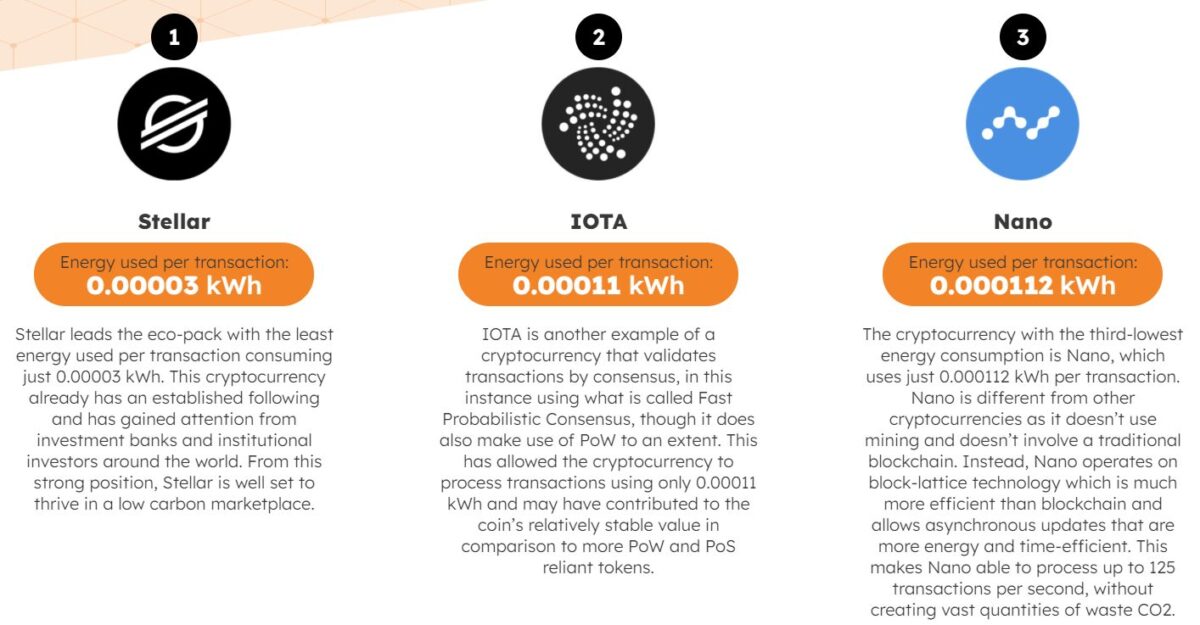Mining cryptocurrencies is a highly energy intensive process that requires computers to solve complex algorithmic problems in order to add to the blockchain and receive cryptocurrency tokens. This process is necessary both to create new tokens and to register transactions on the blockchain.
Forex Suggest looked at some of the most popular cryptocurrencies currently on the market to see how they compare in terms of CO2 emissions, in its Global Impact of Crypto Trading research. Each cryptocurrency uses a different amount of electricity to process a transaction and mine new tokens. This depends on the process that each cryptocurrency uses to add to the blockchain, with some methods being more complex and energy-intensive than others.
Top three cryptocurrencies: comparison in terms of emissions and energy consumption per transaction.
- Bitcoin is by far the most polluting and energy-intensive cryptocurrency out there, using 707 kWh per transaction. This equates to 1,060.5 lbs of CO2 for every transaction, which is just over half a ton. It used by far the most energy of any cryptocurrency in 2020, producing as much as 59.9 million tons of CO2 in just twelve months. In order to offset this gargantuan figure, 299.6 million trees would’ve needed to be planted. This makes Bitcoin an incredibly unsustainable cryptocurrency that will need to reform the way it functions in order to adapt to a low-carbon world.
- Ethereum uses the second most energy for each transaction consuming 62.56 kWh, which produces 93.84 lbs of CO2. Despite being far more efficient than Bitcoin, this is still a very high energy cost that produces a worrying amount of CO2. Ethereum produced the second-highest amount of CO2 in 2020 with 16.6 million tons, which would have required 84.3 million trees to be planted to capture the harmful pollutant. Despite producing much less CO2 over the course of 2020 than Bitcoin, Ethereum is still operating at an unsustainable rate of energy consumption, which makes it one of the dirtiest cryptocurrencies of the last year.
- In third place is Bitcoin Cash, a derivative of Bitcoin. This cryptocurrency uses 19.957 kWh per transaction and produces 28 lbs of CO2.
Other notable unsustainable cryptos are Litecoin, Cardano, and Dogecoin.
Moving to a sustainable future
2021 has been a rollercoaster ride for the crypto community. Record highs in May preceded a sudden slump in values across the market following Musk’s U-turn on accepting Bitcoin as payment at Tesla, and most recently NFTs have driven interest in Ethereum as the uses of blockchain technology become more varied and diverse.
However, with the climate crisis looming and energy shortages striking many countries in the developed world, the energy consumption of cryptocurrencies has never been more under the spotlight.
Some cryptocurrencies are trying to adapt to this changing world by reducing the energy required for transactions to take place on their blockchain. For example, Ethereum is moving to a PoS model from its current PoW method of validating transactions, but is this going to be enough? Or will the crypto community need to adapt to alternative coins and blockchains in order to make the change before it’s too late?
The top 3 least energy-intensive coins:





